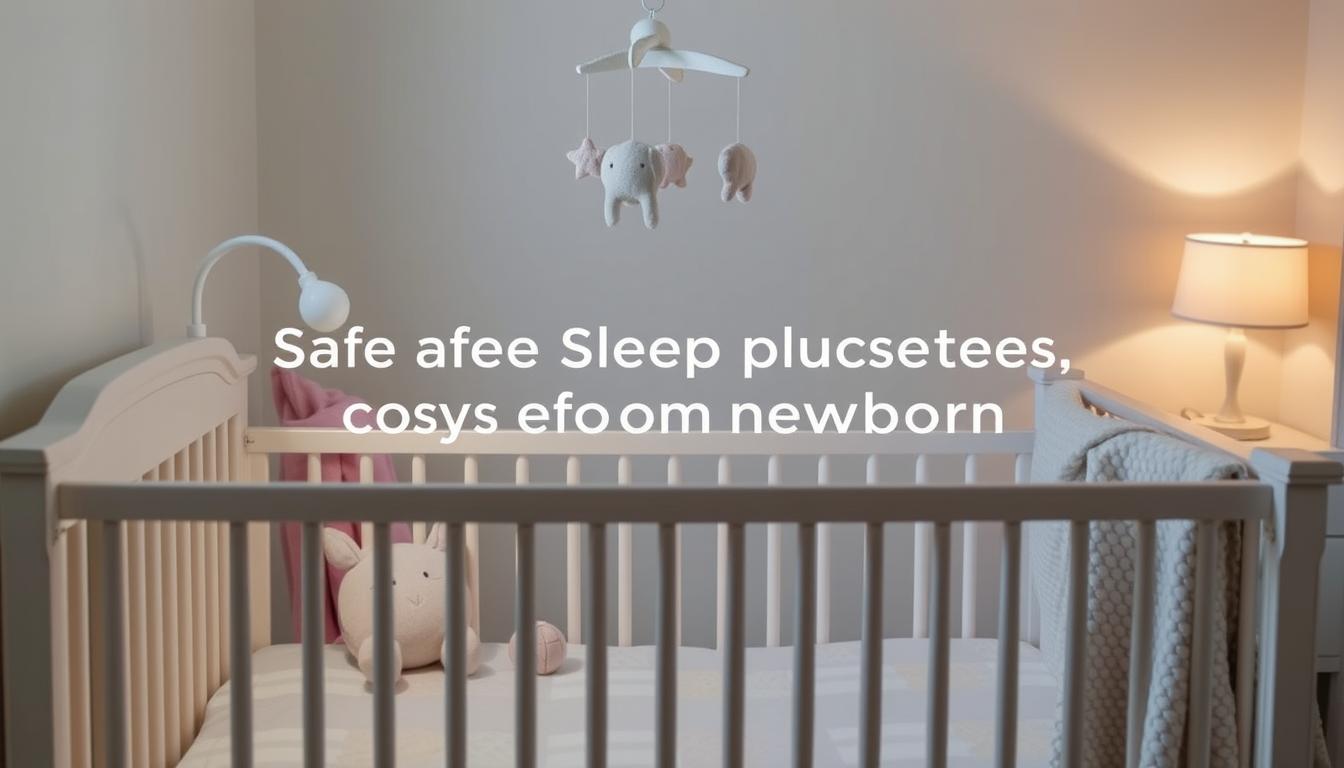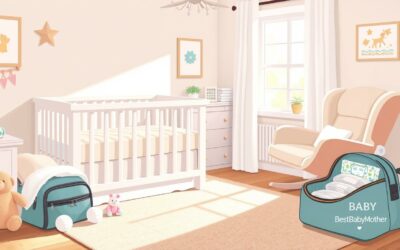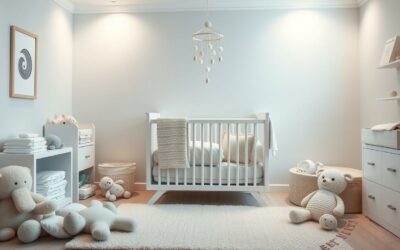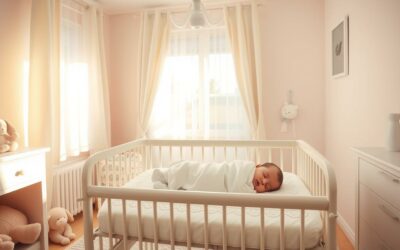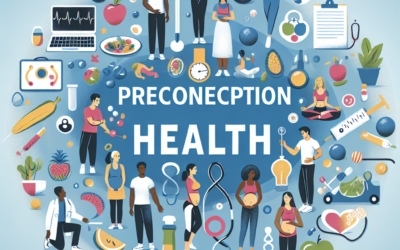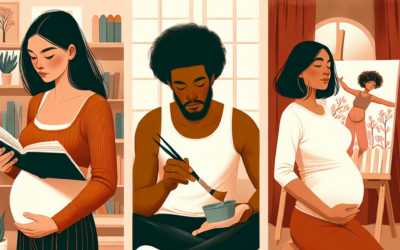Ever wondered why your newborn wakes up just when you’re about to sleep? Learning about infant sleep habits can be tricky. But, with the right help, you and your baby can sleep better. Newborns need 14–17 hours of sleep daily. Matching their sleep with safe habits and routines can make nighttime easier.
Dealing with newborn care means handling frequent feedings and sleep patterns. Whether you’re breastfeeding or bottle-feeding, knowing these patterns is key. The American Academy of Pediatrics suggests room-sharing but not bed-sharing to lower SIDS risk.
Creating a peaceful sleep space and following safe sleep rules is important. It helps both baby and parents sleep better. Explore this detailed guide for tips and strategies to help you sleep better. A well-rested baby means happier parenting.
Key Takeaways
- Newborns need 14–17 hours of sleep per day.
- Breastfed babies eat every 2–3 hours; bottle-fed babies every 3–4 hours.
- Room-sharing is recommended to reduce the risk of SIDS, but avoid bed-sharing.
- Creating a calm sleep environment and routine is crucial for baby sleep improvement.
- Seek professional advice if concerned about your baby’s sleep patterns.
Understanding Newborn Sleep Patterns
Newborn sleep patterns are different from older babies or adults. They sleep in short bursts and wake up for feedings. Knowing these patterns helps you create a good infant sleep schedule for your baby.
Typical Sleep Duration
Newborns sleep about 16 hours a day. They sleep 8 to 9 hours during the day and 8 hours at night. But, some babies might not sleep through the night until they are a year old.
Feeding and Sleep
Feeding and sleep are closely linked in infant sleep schedule. Newborns need to eat every 2-3 hours if they are breastfed. Bottle-fed babies need to eat every 3-4 hours. It’s important to let your baby wake up for food, so they get enough to eat and sleep well.
Sleep Cycles
Newborns have unique sleep cycles. Each cycle has active and quiet sleep, lasting about 40 minutes. During active sleep, babies might move or make sounds. By 3 months, many babies sleep longer stretches at night.
Safe Sleep Practices for Newborns
Keeping babies safe while they sleep is very important. It helps prevent sudden infant death syndrome (SIDS) and other dangers. Sadly, 3,500 babies in the U.S. die each year from sleep-related issues. So, it’s key to follow safe sleep rules.
Sleep Positioning
Safe napping starts with the right sleep position. Always put your newborn on their back to sleep. This is safer than side or stomach sleeping.
Back sleeping also lowers the risk of suffocation and strangulation. These dangers are more common in other positions.
Creating a Safe Sleep Environment
Creating a safe crib area is crucial. Use a firm, flat mattress with a fitted sheet. Stay away from soft toys, pillows, and loose bedding to avoid suffocation risks.
Babies should wear one more layer than adults to stay warm. This prevents overheating.
- Avoid bed sharing – it dramatically increases the risk of SUIDS and suffocation.
- Room-sharing for up to a year with the baby in their own crib can decrease SIDS risk by 50%.
- Opt for a sleep sack or wearable blanket instead of loose blankets for warmth.
- Use of pacifiers at nap time and bedtime can also reduce SIDS risk.
Keeping your home smoke-free is also vital. Smoke is a big risk for sudden unexpected infant deaths (SUIDS). So, avoid smoke before and after your baby is born.
Don’t use products like wedges or baby positioners to prevent SUIDS. They haven’t been proven safe. Only use non-prescription home monitors if a doctor says it’s okay for a medical reason.
Creating an Effective Bedtime Routine
To help your baby sleep well, it’s important to create a bedtime routine. A consistent routine helps your baby relax and sleep better every night.
Bathing and Night Clothes
A warm bath and then changing into night clothes tell your baby it’s bedtime. The warm bath relaxes them, and new night clothes make them feel cozy. This 30 to 45-minute routine helps your baby know it’s time to sleep.
Reading and Lullabies
Reading a story or singing a lullaby makes bedtime calm and peaceful. You can find more sleep tips on baby sleep. Doing the same things every night helps your baby get ready for sleep.
Setting the Atmosphere
A calm and quiet room is key for a good bedtime. Dim lights and less noise tell your baby it’s time to sleep. This helps them sleep longer and grow better. A peaceful bedtime helps your baby sleep well.
The Role of Swaddling
Swaddling has been a way to calm newborns and help them sleep better for a long time. But, it’s important to know the swaddle benefits and how to do it right. This keeps your baby safe and comfortable.
How to Swaddle Correctly
Swaddling can greatly affect how well your baby sleeps. Start by putting a light blanket on a flat area and folding one corner down. Put the baby on their back with their head above the folded corner.
Wrap one side of the blanket around the baby’s body and tuck it under them. Then, bring the bottom of the blanket up over their feet. Finally, wrap the last side around the baby, making sure their hips can move freely.
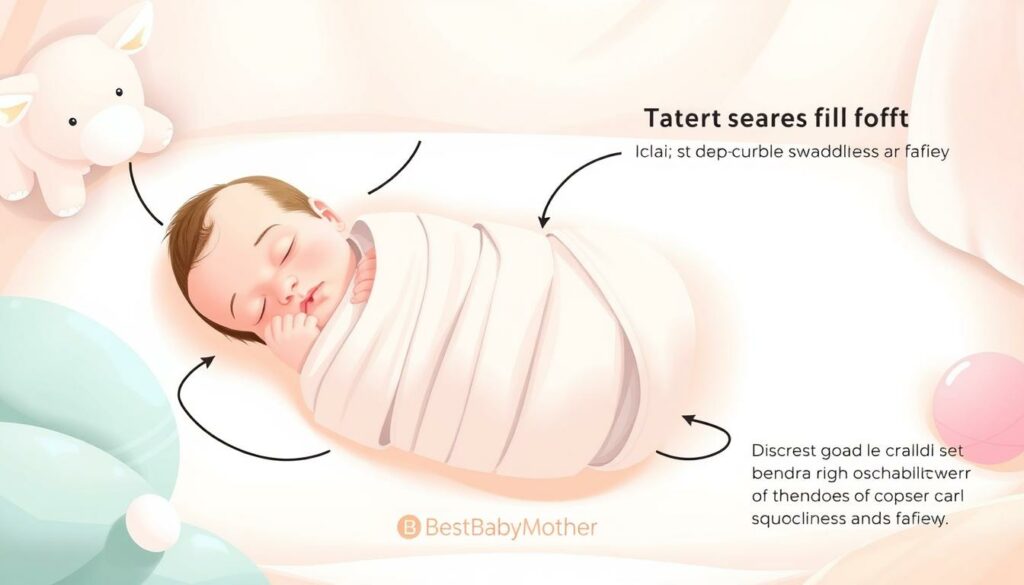
When to Stop Swaddling
Stop swaddling when your baby starts rolling over, usually around 2 months. Swaddling too long can be dangerous, especially if the baby rolls onto their stomach. Always put your baby on their back to sleep.
Watch for signs of too much heat, like sweating or flushed cheeks. This can be a sign of overheating.
| Swaddle Benefits | Risks of Improper Swaddling |
|---|---|
| Calms the baby | Increased risk of SIDS |
| Helps with swaddling and sleep | Potential for hip dysplasia if too tight |
| Reduces startling reflex | Overheating if not monitored |
By following correct swaddling techniques and knowing when to stop, you can make sure swaddling is safe and comforting for your baby.
Benefits of White Noise Machines
White noise machines are great for helping babies sleep. They make a steady sound that helps babies fall and stay asleep. It’s important to pick the right sound and set up the machine right for your baby.
Types of White Noise
There are many kinds of white noise for baby sleep. Each one is good for different babies. Here are some common ones:
- Static Hisses: Sounds like a TV or radio on an unused channel. It’s very soothing for many babies.
- Nature Sounds: Like ocean waves, rain, and streams. These sounds are calming and natural.
- Ambient Sounds: Sounds from fans, air purifiers, or even vacuum cleaner videos. These steady sounds block out sudden noises.
Setting Up a White Noise Machine
Setting up sound machines right is key for their best use and safety. Here are some tips:
- Placement: Doctors say to put white noise machines at least 7 feet from the baby’s crib. This keeps the baby’s ears safe.
- Volume: The American Academy of Pediatrics says to keep the volume under 50 decibels. This is as loud as a hospital nursery. Too loud can hurt your baby’s hearing.
- Consistency: Make sure the sound is steady and smooth. Continuous white noise helps babies sleep better by blocking out other noises.
| Data Point | Statistics |
|---|---|
| White Noise Effectiveness | 80% of newborns fell asleep within five minutes of hearing white noise compared to 25% without it (National Institutes of Health). |
| Volume Recommendation | Sound machines should be set no louder than 50 decibels (American Academy of Pediatrics). |
| Distance for Safety | Pediatricians recommend placing the machines at least 7 feet away from the baby’s crib. |
Knowing how white noise machines work and setting them up right can really help your baby sleep better. These machines create a calm sleep space. This helps both your baby and you get better rest.
Using Pacifiers for Better Sleep
Pacifiers help infants relax and calm down. The American Academy of Pediatrics (AAP) says they can lower Sudden Infant Death Syndrome (SIDS) risk. Knowing how to use pacifiers safely and effectively is key.
Introducing the Pacifier
Start using a pacifier when breastfeeding is strong, usually after three weeks. Research shows it won’t mess up breastfeeding. The AAP says to use them for the first six months for their calming effect.
Benefits and Risks
Pacifiers help babies relax and sleep better. They release endorphins, which are good for calmness. They also give comfort and security, especially for newborns.
But, there are risks with long-term use. Babies might get ear infections, oral thrush, or intestinal infections. They can also face dental issues later. The AAP recommends stopping pacifier use by four months and switching to stuffed animals by 12 months.
Following the right steps, the benefits of pacifiers can be great. For more info, check out the Sleep Foundation’s guide on pacifier use.
Understanding and Managing Sleep Deprivation
Having a new baby means lots of sleepless nights. It’s hard for parents to get enough rest. Knowing the signs and finding ways to cope can help a lot.
Signs of Sleep Deprivation in Parents
Parents who don’t sleep well might feel:
- It’s hard to focus and remember things.
- They get moody and irritable.
- They always feel tired.
- In some cases, it can lead to depression.
A 2019 study found that over 2,000 German parents slept less and were less satisfied with their sleep in the first three months. It can take up to six years to get back to pre-pregnancy sleep levels. This shows how important it is for new parents to manage their sleep.
Coping Strategies
Here are some ways to deal with sleep loss:
- Share nighttime duties: Take turns feeding the baby at night.
- Prioritize nap times: Sleep when your baby sleeps.
- Minimize nonessential tasks: Focus on rest and important tasks early on.
- Practice good sleep hygiene: Keep the sleep area cool, quiet, and dark.
- Limit caffeine intake: Don’t have more than 200 mg of caffeine a day to avoid sleep problems.
Remember, sleep problems are temporary. Managing sleep is key for parents’ health and creating a good home for the baby.
| Statistics | Insights |
|---|---|
| Moms and dads experience poor sleep in the three months following birth. | Sleep deprivation is common and affects parents’ overall health. |
| Postpartum depression affects 8-13% of new mothers. | Managing sleep is vital to minimize the risk of depression and mood symptoms. |
| Study findings: Sleep training around six months improves maternal mood. | Implementing strategies to enhance infant sleep positively impacts parents. |
| Caregivers with fragmented sleep show less positive parenting behaviors. | Prioritizing parent’s sleep leads to better caregiving practices. |
Newborn Sleep Training Basics
Learning about sleep training methods is key for new parents. It helps babies sleep better and longer. Experts say to start when your baby is 4 to 6 months old. But you can begin early.
Teaching your baby to sleep well starts early. Newborns sleep a lot, up to 20 hours a day. They wake up for short times, not over 2 hours.
At first, they wake up at 8:30 am and nap on and off. They eat last at 9 or 9:30 pm. Then, they wake up at 1 am and 4:30 am for more food.
- Set a bedtime routine to help your baby sleep better. This can include a warm bath, rocking, and feeding.
- How you handle night wakings is important. Some methods let the baby self-soothe before you help.
- Teaching your baby to self-soothe is a big step. Methods like cry-it-out or Ferber use timed crying to help them sleep.
As your baby grows, so does their sleep routine. For example:
- By week 3, start a flexible schedule for eating, being awake, and sleeping.
- At 4 weeks, you might notice a sleep pattern with your baby.
- By 2 to 3 months, babies start to follow routines and schedules.
- At 4 to 6 months, you can start more formal sleep training as their sleep changes.
Studies show sleep training doesn’t harm a child’s behavior or emotions later. Experts say it’s safe and important for a baby’s growth.
Infant sleep coaching can be a smart strategy. There are many methods, like cry-it-out, Ferber, and pick up, put down. Success often takes two full weeks of being consistent.
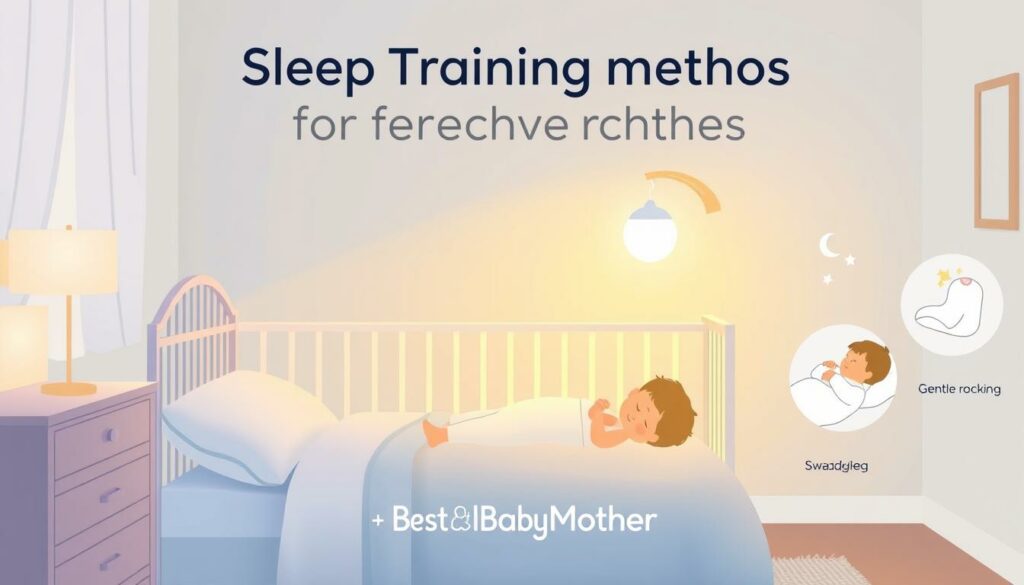
Room-sharing vs. Co-sleeping
Choosing the right sleep arrangement for your infant is key for their safety and your peace of mind. Room-sharing, where the baby sleeps in a crib or bassinet in the same room as the parents, is widely recommended by health experts. On the other hand, co-sleeping, specifically bed-sharing, poses several risks, including suffocation and SIDS (Sudden Infant Death Syndrome). Knowing the differences between these two arrangements and their implications can help you make an informed decision.
Pros and Cons of Room-sharing
Room-sharing is endorsed by the American Academy of Pediatrics (AAP) as it can reduce the risk of SIDS by up to 50% during the first 3 months of life. Having your baby nearby makes nighttime care easier, making feedings and monitoring more convenient. However, after about 4 months, room-sharing might disrupt your baby’s sleep due to increased night wakings and awareness of their surroundings. As babies grow, they might require more nighttime care, which can lead to unsafe practices like being pulled into the parents’ bed.
Dangers of Co-sleeping
Co-sleeping is not safe for infants and is discouraged by the AAP due to the elevated risk of suffocation and SIDS. The Centers for Disease Control and Prevention (CDC) reports that about 3,400 babies die in the United States every year from sleep-related causes, often linked to co-sleeping hazards. Sharing a bed with your baby can significantly increase the chances of accidental overlaying or entrapment between sleep surfaces and bedding materials.
While some cultures practice various forms of co-sleeping, it is essential to prioritize safety. Room-sharing with a separate sleep surface for your baby combines accessibility with the critical aspect of reducing SIDS risk. Always ensure that the baby’s sleep area is clutter-free and adheres to recommended safety guidelines to foster a secure sleep environment.
FAQ
How much sleep do newborns need?
Newborns need 14–17 hours of sleep each day. Some might sleep up to 18-19 hours.
How often should I feed my newborn at night?
Breastfed babies need to eat every 2–3 hours. Bottle-fed babies might eat every 3–4 hours. Feed them as needed for growth.
Why does my newborn have irregular sleep patterns?
Newborns don’t have a mature sleep cycle. They sleep in short bursts. Their sleep patterns change as they grow, getting longer by 2–3 months.
What is the best sleep position for my newborn?
The back sleeping position is safest. It lowers SIDS risk. Always put your baby on their back to sleep.
How can I create a safe sleep environment for my newborn?
Use a firm, flat surface with fitted sheets. Avoid loose bedding and soft objects. Don’t overbundle or overheat your baby. Room-sharing without bed-sharing is safest.
How do I develop an effective bedtime routine for my baby?
Start with a warm bath and night clothes. Add soothing activities like reading or lullabies. A dim room helps your baby relax at bedtime.
What is swaddling and how do I do it correctly?
Swaddling wraps your baby in a light blanket. Make sure it’s not too tight and lets their legs move. Stop swaddling when they start rolling over, around 4 months.
Are white noise machines beneficial for newborn sleep?
Yes, they provide a soothing background noise. This helps newborns sleep better by blocking out other sounds. Keep the machine safe and not too loud.
Can a pacifier help my baby sleep better?
Pacifiers can comfort your baby and lower SIDS risk. Introduce them after breastfeeding is established. Be careful of dental issues and ensure it’s safe for your baby’s age.
How does sleep deprivation affect parents and how can they manage it?
Lack of sleep can make it hard to focus and remember things. It can also change your mood. Share nighttime duties, nap when you can, and rest when your baby does. Remember, this is temporary.
What are the basics of sleep training for newborns?
Sleep training helps babies sleep better on their own. Start early concepts, but formal training is best after 4-6 months. Consistent bedtime routines and responses to night wakings are key.
What are the benefits and risks of room-sharing vs. co-sleeping?
Room-sharing means the baby sleeps in a separate crib in your room. It’s safe and easy for care. Co-sleeping is risky due to suffocation or SIDS. Always use safe sleep surfaces and keep the area clear.

